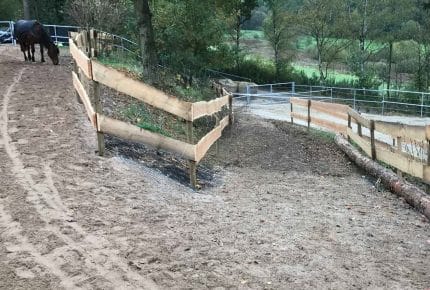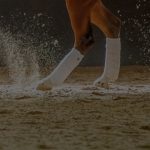Relish Riding in the Rain with a Mud-Free Arena
While it can be fun riding in the rain, it is no fun at all to ride on a slippery and muddy arena surface. Not to mention the harm it does to your arena base! No matter where you live, East Coast or West Coast (in the winter), we all know that only a few inches of rain can turn your arena into a lake overnight. Without a proper base, it can take 2-4 days of sunny weather to dry up again.
When building a new outdoor arena, always go the extra mile and cost to build a free draining base for an all-season, all-weather riding arena. In the end, it will save you time and money! But what exactly is an all-weather arena, and how is it different?
What is an All-Weather Riding Arena?
A true all-weather riding arena is one you can ride on 365 days a year, rain or shine. It consists of 3 components to keep your riding surface mud-free:
- The sub-base
- Separation layer between sub-base and the horse arena footing
- The arena footing
1. Construction of The Sub-Base
A great arena starts at the (sub) base! Building an all-weather riding arena sub-base includes:
- Grading the natural soil at 1%
- Putting landscape fabric above the natural soil
- Adding a layer of 5-8 inches of DrainRock gravel at a 1% slope
2. Separation Layer between the Sub-base and Footing
We recommend DrainGrids or arena mats as the permanent separation layer between the sub-base and the riding surface.


Do NOT use a membrane or landscape fabric only as the separation layer. Many companies still build a free draining base with just a separation layer of a geotextile liner. These tend to move and shift over time and come up into your arena footing, creating hazards for your horse.
3. Arena Footing
The arena surface for all-weather arena footing consists of a fine, clean, washed sand mixed with geotextiles sand additives above the HIT DrainGrids or Euro Arena Mats. Avoid using sands with clay and silt content as they inhibit the drainage!
Please contact us for the best sand selection or read more in our Horse Arena Footing 101 article.
If you follow all these steps and do not take any short cuts, you will have a perfect all-weather riding arena for the next 15-20 years. So you can put on your jacket, pull on the gloves, and step out into the rain, and you and your horse will be in it together on a safe and mud-free surface!














 Geotextile Arena Footing
Geotextile Arena Footing Ground Mats and Grids
Ground Mats and Grids Subsurface Irrigation
Subsurface Irrigation Arena Drags & Groomers
Arena Drags & Groomers Mirrors and Kickwall
Mirrors and Kickwall Horse Wellness
Horse Wellness Dust Control
Dust Control